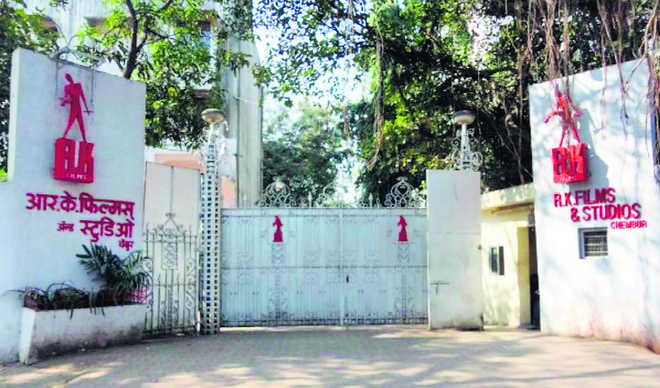Saibal Chatterjee
In an industry that thrives on moving with the times, change is inevitably the only constant. Yet, when news of a significant piece of Hindi cinema history — RK Films & Studios — being put on sale arrives, one cannot but feel a twinge of sadness. Both the banner and the space have had iconic status in the minds of Mumbai film practitioners as well as movie fans weaned on the magic of producer-director-writer Raj Kapoor’s work.
Set up in 1948 by the man widely accepted as “the greatest showman Indian cinema has ever seen,” the studio has been witness to the making of some of Hindi cinema’s most iconic films over the decades. Its dismantling, when it does happen, will be heartbreaking. It will bring the curtains down on a glorious chapter of Hindi cinema.
A devastating fire last year during the shoot of a reality show was the beginning of the end for the 70-year-old RK Studios as the world knows it. On the premises were preserved costumes worn by the likes of Nargis, Vyjayanthimala, Padmini and Aishwarya Rai. These were all destroyed, along with other priceless memorabilia from the golden age of the Hindi movies.
On September 16, 2017, Rishi Kapoor posted a photograph of a burnt portion of the studio and tweeted: “Gutted by a devastating inferno. Scars shall remain but will build a state-of-the-art studio.” But that is not to be. The Kapoor brothers — Randhir, Rishi and Rajiv — have decided that the cost of rebuilding and reviving RK Studios will not be too steep for comfort and it is, therefore, best to sell off the prized property.
Randhir Kapoor, whose daughter Kareena Kapoor continues to extend the family’s legacy, has said that they have taken the decision “with a heavy heart”, while Rishi, announcing the move to the world, admitted that the studio was “a huge white elephant incurring heavy losses” for several years now.
Although the studio is still being hired by television producers, its location — Chembur in the eastern suburbs of Mumbai — works against it. The prime Bollywood action has shifted primarily to Goregaon’s Film City and the Andheri studios. Mumbai moviedom has turned away from RK Studios. That has obviously taken a toll on its profitability.
Time is ruthless in its march. Since Raj Kapoor’s demise in 1988, when Randhir took over the reins, RK Studios has been lurching from crisis to crisis. The last film that the family patriarch began to work on — Henna (1991) — had to be completed by Randhir Kapoor owing his father’s ill health. The film, starring Rishi Kapoor opposite Ashwini Bhave and Pakistan’s Zeba Bakhtiar, was a commercial success but the production banner wobbled through the subsequent years.
The banner’s two subsequent films — Prem Granth (1996), directed by Rajiv Kapoor with Rishi Kapoor and Madhuri Dixit in the cast, and Aa Ab Laut Chalen, an Akshaye Khanna Aishwarya Rai-starrer helmed by Rishi Kapoor (the only film he ever directed in his career) — failed to yield the expected boxoffice returns. Aa Ab Laut Chalen was to be the last film made under the RK Films banner.
Although there was some talk in recent years of Ranbir Kapoor making a move to revive the banner founded by his illustrious grandfather, no real revival plan was ever put in motion. Ranbir’s acting career has kept him far too busy to devote time to the business aspects of RK Studios. The family as a whole did toy with the idea of upgrading the studio with the induction of state-of-the-art technology. The intention remained on paper.
The studio’s recent struggles are obviously a far cry from its heydays, which saw the making of a string of wonderful films that quickly became part of Hindi cinema folklore. Aag, RK Films’ first production, was a commercial disaster, but the studio’s very next film, Barsaat, was a humongous success. A moment from the film — it had Raj Kapoor with an umbrella in one hand and a guitar in the other holding Nargis in an embrace — became the production company’s logo.
Thanks to Raj Kapoor’s sustained magic touch, RK Films went from strength to strength. From Awara (1951) and Shri 420 (1955) to Ram Teri Ganga Maili (1985), the last film whose production Raj Kapoor personally supervised, the company churned out megahits. Despite the major commercial setback that the failure of the showman’s most ambitious project, Mera Naam Joker (1970), represented, he bounced back with Bobby (1973) and Satyam Shivam Sundaram (1978).
With the passing of the studio that also gave us films like Jis Desh Mein Ganga Behti Hai, Sangam and Prem Rog, the Mumbai movie industry will lose one of its last links with its greatest phase of productivity: an irreparable damage.
Unlock Exclusive Insights with The Tribune Premium
Take your experience further with Premium access.
Thought-provoking Opinions, Expert Analysis, In-depth Insights and other Member Only Benefits
Already a Member? Sign In Now











